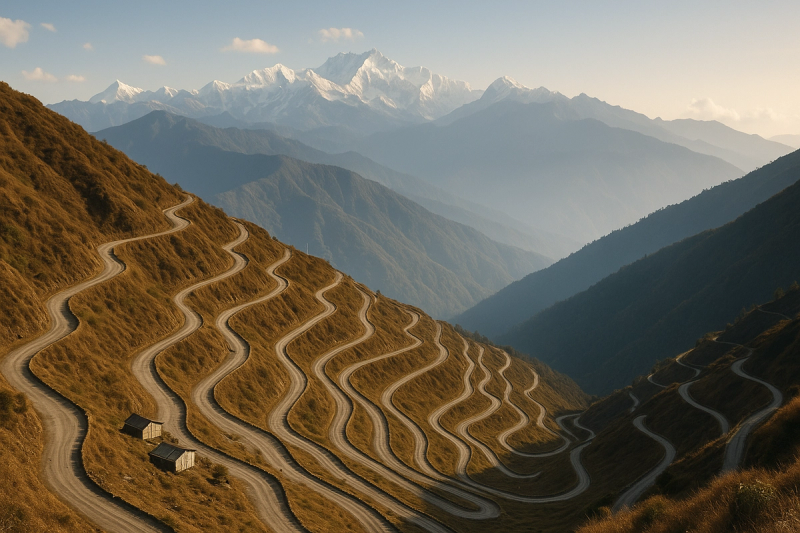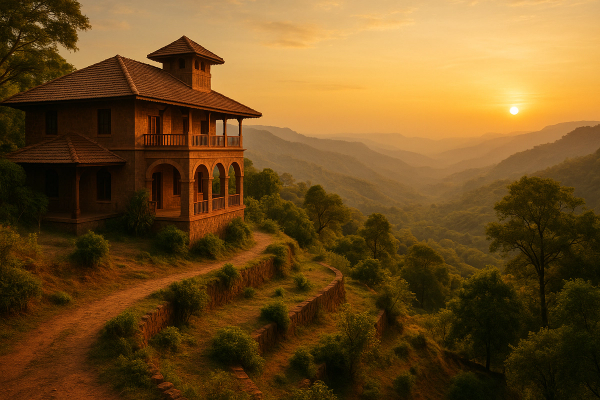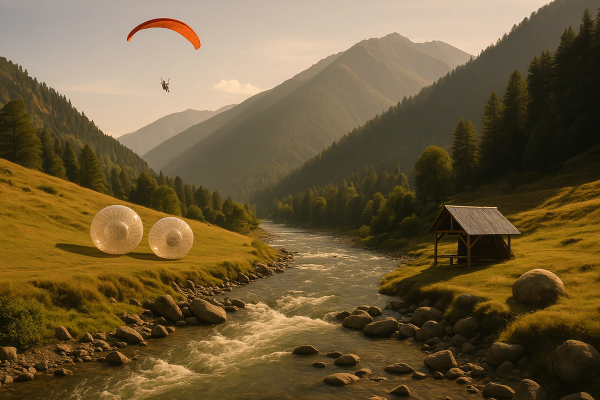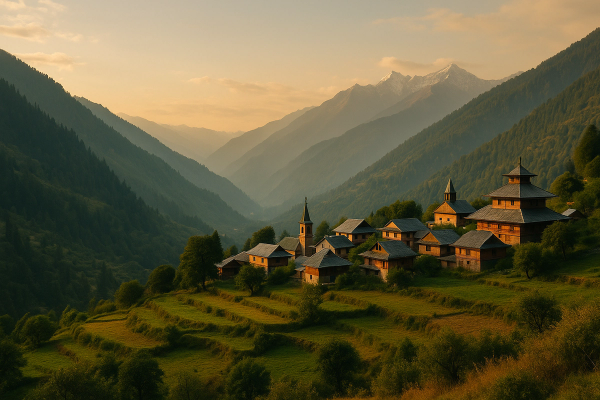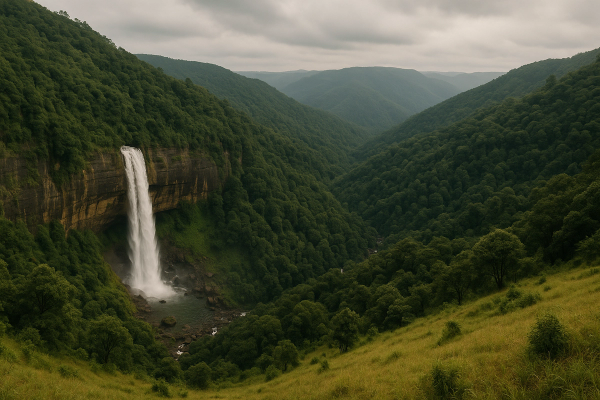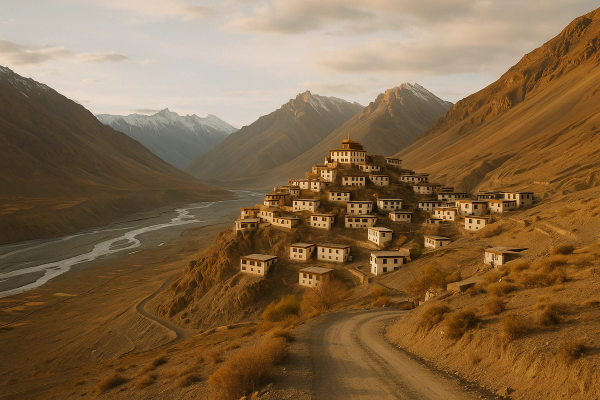Silk Route to Zuluk: 5-Day Sikkim & East Himalaya Drive – a slightly chaotic, very beautiful roadtrip#
You know how some trips just kind of sit in your head for years and then one random day you’re like, bas, now. This Silk Route drive was that for me. Me and my cousin booked a last-minute cab from Siliguri, stuffed our winter jackets and Parle-G into one duffel, and pointed the car towards East Sikkim. Zuluk. Gnathang. Kupup. Those names sound like made-up fairyland nonsense until you drive into the clouds and actually see the zig-zag loops, the prayer flags flapping, the cold air that hits your bones, and the chai stall aunty who tells you the weather forecast better than any app. It’s not a fancy roadtrip. It’s raw, moody, very Himalayan. And honestly, it felt like home in a weird way… with altitude headaches and momos.¶
What exactly is the Old Silk Route and why everyone keeps talking about Zuluk?#
Okay so, quick background. The Old Silk Route is one of the ancient trade links connecting India to Tibet through Sikkim, specifically via the Jalep La area. You still see remnants of the military roads, old bunkers, and those famous hairpins near Zuluk. People come here for two big things: the loops (I swear the Instagram reels don’t lie) and the feeling of being absolutely tiny in the East Himalaya. Zuluk itself is a small settlement around 9,400 ft, kind of perched on a slope, and it’s not polished. It’s basic. The beauty is in the simplicity: homestays with wooden rooms, steaming bowls of thukpa, sunrise at Thambi View Point where the entire mountain range decides to show off. Further ahead is Gnathang Valley, about 12,000 ft, this wind-swept plateau where you can literally hear the silence. Kupup Lake, which the locals call Elephant Lake because it looks like one from top, sits like a jewel. The route touches some sensitive border areas, so there’s army presence and multiple checkposts. All in all, this drive is the real deal. Not touristy-shiny, but pure.¶
Our 5-day Silk Route plan that actually worked#
Different folks do different itineraries, some start from Gangtok and loop back, some go only till Zuluk and return. We started from Siliguri because flights were expensive that week and also because I kinda love trains. The rhythm of this route is, honestly, decided by weather and permits. But here’s how me and him went about it. No frills, just practical stops, chai breaks, and that one emergency Maggi at Padamchen when it got too foggy to drive.¶
- Day 1: NJP/Bagdogra to Aritar or Rongli. We took a cab from NJP around 9 am, stopped for breakfast at Rongpo for hot puri sabzi, then headed to Rongli for the permit. If you’re staying at Aritar (Lampokhari lake), do a relaxed evening walk and sleep early. Altitude starts climbing from here. Homestays around Aritar are 1200–2000 per person with meals. We paid 1500 each, got a simple room, clean washroom, bucket hot water. Perfectly fine.
- Day 2: Aritar to Zuluk via Padamchen. This day is for the climb and the views. The forests around Padamchen were misty like a movie scene. Detour to Que Khola Falls if you have time. We reached Zuluk by late afternoon and checked into a homestay right on the bend of the village. That golden hour when clouds move like a slow river… uff. Dinner was rice, dal, sabzi, and egg curry. Nothing fancy but soul food. Sleep early. The cold bites.
- Day 3: Zuluk loops, Thambi View Point, Lungthung, Gnathang Valley. We woke up at 4:45 am. I am not a morning person, but trust me yaar, sunrise at Thambi is worth every yawning minute. The iconic zig-zag loops look unreal from here. You can see the entire road belly dancing across the mountain. We pushed on to Lungthung for tea, then drove into Gnathang Valley. Stayed the night. It’s high altitude, so move slow, keep water intake up, no heavy dinner. Gnathang nights are for star-watching if the sky is clear. I literally stood outside wrapped in two shawls shaking like a leaf and still couldn’t stop staring.
- Day 4: Gnathang to Kupup, Tukla area, Baba Mandir, then towards Tsomgo Lake and Gangtok. Kupup’s Elephant Lake is stunning. We stopped at Baba Harbhajan Mandir (there are two, old and new one), took a small break, and then drove towards Tsomgo. Yak rides are still popular there, and yep, the ropeway is fun if you’re not afraid of heights. Reached Gangtok by evening, checked into a mid-range hotel near MG Marg. Hot showers, wi-fi, momos with chutney that ruins every diet.
- Day 5: Gangtok slow day and return. We grabbed breakfast at a local cafe, walked MG Marg, bought local tea and churpi, then started back to Siliguri by noon-ish. If you’ve got time, add Rumtek Monastery or Temi Tea Garden on your way. But we were done—happy-tired and, basically, ready for a long train nap.
Permits, checkposts, and the latest updates you shouldn’t ignore#
So, permits. The Old Silk Route falls under protected areas. Indian nationals need permits that are generally issued at Rongli checkpost or through local tour operators. Carry original IDs, a couple of passport-sized photos, and car papers if you’re self-driving. Permits also cover your vehicle. And remember, certain stretches only allow Sikkim-registered vehicles beyond checkposts, so many travellers hire local cabs from Rongli or Gangtok to avoid drama. Foreign nationals need a Protected Area Permit and usually have to travel in groups with pre-booked guides. As of early 2025, the permit process is pretty much the same, but the officers can be strict if the weather is bad or the route is temporarily closed. Army checkposts will verify your papers at multiple points. No drones, no clicking photos in restricted zones, and please don’t argue with the jawans—this is their workplace, not Insta backdrop. If your plan includes Nathu La, that’s a separate permit from Gangtok, and it’s off-limits for foreigners. Also, Mondays are tricky, sometimes the route to Tsomgo and Nathu La stays shut depending on regulations and weather. Always double check day-before.¶
Road conditions, safety, altitude, network—basics that make or break your trip#
The road is beautiful but not forgiving. It’s narrow, sometimes broken, and in monsoon months you might face landslides. Winter brings black ice, and Gnathang can get brutally cold. If there’s heavy snow, the route past Zuluk can shut—homestays then become full, cash runs out, and drivers need chains for tires. Start early, drive slow, and don’t do aggressive overtakes. Altitude-wise, Gnathang sits around 12,000 ft. Some people feel dizzy, get headaches, or nausea. Move slowly, keep warm, avoid alcohol, and consult your doc if you plan to carry Diamox or similar. I’m not your medical guide, but just… listen to your body. On the network front, Jio worked in patches, Airtel was moody, BSNL sometimes saved the day near Aritar and Rongli. After Padamchen the network becomes basically hide and seek. ATMs are available in Rongli and Gangtok, but hardly anywhere mid-route. UPI works in many places, but don’t depend on it blindly. Carry enough cash. Oh, and keep some loose change. Toilet facilities are simple. Homestays do their best, but expectation management is key. This is high mountain life, not a 5-star.¶
Where to stay on the Silk Route and roughly how much you’ll spend#
Stay options are mostly homestays in Aritar, Padamchen, Zuluk, and Gnathang. In Aritar, we paid 1500 per head including dinner and breakfast. In Zuluk, expect 1400–2200 per person per night with meals, depending on season and what kind of room you pick. Gnathang homestays can be a bit more because of altitude and supply costs, around 1800–2500 per person. In Gangtok, mid-range hotels are 1800–4000 per room per night, sometimes higher in peak season. Bookings—honestly—work best through local operators or by calling the homestays, though you’ll find many on WhatsApp groups or smaller listing sites. Electricity cuts happen. Geysers can be slow. Rooms will be wooden, simple, clean. If you want plush, stay in Gangtok at the end. Pro tip: ask about blankets and extra quilts. And carry a good thermos. We used ours like crazy. Parking is a pain in some places, but drivers manage. Always tell the homestay your ETA—they’ll keep food ready, which is the sweetest thing ever.¶
Food that warmed my soul (and frozen fingers)#
Sikkim food is straight comfort. We ate steamy thukpa and thenthuk, momos with spicy chutney that made us tear up, and this deep-fried meat pie called shaphaley that is sinful in the best way. Churpi, the local cheese, appears in soups and sometimes as chewy snacks. A yak-meat dish called phagshapa is spicy and lovely if you can find it. In homestays you’ll mostly get rice, dal, mixed veg, egg curry or chicken curry. Breakfast is aloo paratha or toast-omelette. Maggi is the mountain emergency food, like always. Tea is the hero—milk chai, butter tea if you’re adventurous. Costs are reasonable: homestay meals are included, but if you eat at roadside dhabas, expect 120–200 for thukpa, 120–180 for momos, 40–60 for chai. Please don’t litter. Sikkim has a strong plastic-free vibe. Carry your bottle, refill whenever. That warm steel glass of chai at Lungthung, with wind cutting across… I swear I can still feel my nose turning into ice cube.¶
Lesser-known stops, and a few detours worth your time#
If you like small detours and half-hidden places, this route keeps surprising you. Lampokhari (Aritar Lake) has a scenic trail, do the loop walk in the morning. Padamchen’s forest line is dreamy when mist rolls in. Que Khola Falls near Rongli is a quick splash-and-go. Kupidara viewpoint sometimes gives wide-open views if the clouds behave. Menmecho Lake is in the region but generally off-limits, falling in sensitive area—ask locally, but don’t push rules. Tukla area has old war memorials and interesting landscapes. Thambi View Point is famous, but if you walk a bit further up the ridge you get quieter corners. In Gangtok, try a cafe crawl near MG Marg, then move to the back lanes for local bakeries. If you get extra time, Rumtek Monastery and Temi Tea Garden add a softer cultural finish after the rugged Silk Route workload. Oh, and there’s a small museum vibe near Kupup explaining the trade route history—ask your driver, these guys know hidden gems better than Google, no jokes.¶
Budget snapshot so you don’t overthink the kharcha#
Money talk, quickly but honestly. For a 5-day trip, with two people sharing: cab hire for Silk Route (including Gangtok drop) was around 18,000–26,000 depending on season and vehicle type. Our driver charged 21k all-inclusive of fuel. Homestays: 1400–2500 per person per night including meals. We did 3 nights homestays and 1 night hotel in Gangtok, so about 9k–11k per person for stays. Food extras and chai: 1,500–2,500 per person total. Permits are usually nominal or included with operator; parking tips and small fees: 500–1,000. Total ballpark per person: 15k–25k for basic-comfort style. You can cut costs by taking shared cabs to Rongli, then hiring a local shared vehicle for the Silk Route portions, but shareds might be irregular and depend on season. Also, carry 8–12k cash minimum. UPI works but can misbehave after Padamchen. And don’t forget emergency chocolate budget. Yes it’s a thing.¶
Best months to visit and packing that actually helps#
Season-wise, October to November is gold for clear skies and views. Spring, April to early May, gives you rhododendrons and pleasant temps. Winter, December to February, is magical for snow but can mean route closures, and Gnathang becomes frigid. Monsoon, June to September, is green and moody but landslides happen—only go if you’re okay with plans changing. Packing list that saved our backs: proper winter jacket, a fleece mid-layer, thermal inner, wool cap, gloves, good socks, waterproof shoes, rain cover for backpack, a small torch, power bank, basic meds for cold and nausea, ORS, sunscreen, lip balm, wet wipes, and a reusable bottle. If you use cameras, keep extra batteries. Drones are a no near army zones, so don’t. We carried a small humidifier hack (literally a reusable cloth near the kettle) because the room air gets dry at altitude. Not necessary, but my skin said thanks. Oh and snacks—nuts, chocolate, khakra, whatever you love. Food is available, but sometimes you reach a homestay late and your stomach does drama.¶
Culture, respect, and the eco side of this route#
This drive crosses tiny villages and army areas. Keep voices low near checkposts. Ask before photographing locals. Don’t pick flowers or mess with prayer flags. Sikkim has a good reputation for cleanliness and green policies, so help keep it that way. Bin your waste properly, or carry it out. Language is a mix—Nepali is common, you hear Bhutia and Lepcha too, but Hindi and English will do fine. Try saying namaste or tashi delek with a smile. If a homestay aunty tells you to wear a cap, wear it—mountain wisdom beats Google. Also, be kind while bargaining. Locals are not trying to loot you, costs are genuinely higher because supplies have to climb the hills on trucks. Lastly, while the Silk Route is now famous on reels, it’s still a fragile place. If the road closes or the officer says no, just… chalo, we adapt. No trip is worth risking safety.¶
Transport options and how to plan without losing your mind#
Easiest entry points are New Jalpaiguri (NJP) railway station or Bagdogra airport. From Siliguri, hire a cab to Rongli/Aritar. You can pre-book a Sikkim-registered vehicle for the entire route, which is smartest because checkposts sometimes get fussy with outside plates. Rates vary, so get 2–3 quotes on WhatsApp from local operators, confirm inclusions, and ask if permits are handled. Self-drive? Possible, but I wouldn’t recommend unless you’re comfortable with narrow mountain roads, fog, and altitude. Also be ready for permit nuances and the occasional roadblock where only local drivers know the workaround. Shared cabs exist between Siliguri–Gangtok–Rongli, but you’ll spend more time waiting and you’ll miss sunrise runs. Booking stays—call the homestays directly or message them, even if you found them online. They’ll guide you on current weather and road status better than any app. Also quick planning tip: keep one buffer day. If the road closes, you won’t be stressed out about missing your train.¶
There’s a moment at Thambi when the sun hits the loops and everything turns honey-gold. I don’t know what changed inside me at that time, but something softened. Maybe it’s the mountains. Maybe it’s the quiet. Maybe it’s just hot chai at 12,000 ft.
Important bits you’ll thank me for later#
- Start early every day. Fog builds post-late morning. - Don’t overpack, but pack smart layers. - Keep cash. - Tell your driver you want sunrise at Thambi. He’ll grumble but he’ll do it. - Read weather the day before. Local police and Army know best. - If you feel off at Gnathang, don’t push. Hydrate and rest. - Try shaphaley and churpi soup at least once. - Always have one power bank and one extra charging cable tucked in your jacket pocket like your life depends on it. - Don’t litter. Please. I saw plastic near a viewpoint and felt genuinely angry. - Lastly, smile and talk to people. Locals are kind and funny. One aunty gave us free wai-wai because we looked too cold. Saints walk among us in socks.¶
Would I go back? In a heartbeat.#
I’ll go again for the sunrise and the way those loops look from the ridge. For the wind at Gnathang that almost pushed me back into the homestay door. For the tea at Lungthung that tasted like peace. For the stray puppy at Zuluk who followed us till the next bend then got bored and turned back. For that feeling of being small and happy. Next time I’ll add Temi Tea Garden properly and maybe a few extra days for a Gangtok food crawl. But I won’t change the basics: early starts, easy pace, lots of chai stops, and staying in homestays where you hear real stories of the route. I didn’t expect to like the Old Silk Route this much. I thought it’d be a tick-mark destination. Nope. It got under my skin.¶
Final travel thoughts#
If you’re dreaming about the Silk Route to Zuluk, stop overthinking and just plan it. Keep your itinerary flexible, your backpack light, and your heart open. This drive isn’t about luxury. It’s about quiet roads, weather mood-swings, simple meals, and big views. A very Indian kind of trip with small joys that linger. If you want more travel stories and practical guides that don’t feel like robot copy, check out AllBlogs.in. I find their stuff helpful when I’m scribbling routes on chai-stained paper and deciding which mountains to chase next.¶

